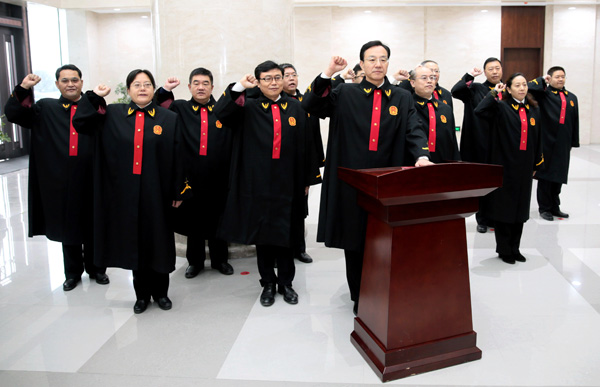
Judges at the Supreme People's Court's Sixth Circuit Court in Xi'an, Shaanxi province, swear an oath of allegiance. (Photo/Xinhua)
Regional branches of the Supreme People's Court are providing greater flexibility and changing the way litigants and legal professionals approach cases
For many years, Huang Sizhou, a lawyer in Shenzhen, in the southern province of Guangdong, frequently traveled to Beijing in the north of the country to attend appeal hearings at the Supreme People's Court (the country's top legal chamber). Sometimes, he spent days away from his family.
Now, Huang's traveling days are over. "The Supreme People's Court has established a circuit court in Guangdong, which means I can help clients resolve disputes and have face-to-face talks with judges from the top court without leaving my hometown," said Huang, who specializes in civil and commercial cases.
The first two circuit courts were opened in 2015 to enforce judicial reforms, improve efficiency and provide litigants with better legal services.
The First Circuit Court, in Shenzhen, is responsible for cases from the provinces of Guangdong and Hainan, and the Guangxi Zhuang autonomous region, while the Second Circuit Court, in Shenyang, capital of Liaoning province, oversees disputes in the northeastern provinces of Liaoning, Jilin and Heilongjiang.
As branches of the country's top legal tribunal, the two courts are further reinforcing the rule of law, which has been promoted by the central leadership since 2014.
Statistics published in March show that in the past two years, the two branches shared 4,721 cases, 4,573 of which had been concluded. Before the circuit courts were established, those cases would have been added to the work of the Supreme People's Court in Beijing.
The success of the move resulted in four more circuit courts being established at the end of last year: in Zhengzhou, Henan province; Nanjing, Jiangsu province; Chongqing municipality; and Xi'an, Shaanxi province.
"It means the top court's arms have extended across the country," said Xu Jiaxin, director of the Supreme People's Court's political department.
He added that the new courts aim to further narrow the gap between the top court and the public by helping to resolve disputes without people having to travel to Beijing: "They are also the key to unifying standards for case hearings to ensure litigants receive considered, high-quality verdicts, and improving court efficiency."
A dream come true
One of Huang's clients in Jiangxi province wanted his case to be heard at the circuit court in Shenzhen rather than Beijing, but that wasn't possible because his hometown is not within its jurisdiction.
Things changed on Dec 28. "His dream came true because the Third Circuit Court was established in Nanjing to hear cases from Jiangsu, Zhejiang, Fujian, Jiangxi and Shanghai," Huang said.
On the same day, the Fourth Circuit Court was established in Zhengzhou, Henan province, covering cases in the provinces of Henan, Shanxi, Hubei and Anhui. On Dec 29, the fifth and sixth branches were opened in Chongqing and Xian respectively to oversee cases in the country's southwestern and northwestern regions.
Meanwhile, the First Circuit Court will soon begin accepting cases from Hunan, and the Supreme People's Court is now responsible for hearing lawsuits from Beijing, Hebei province, Tianjin municipality and the Inner Mongolia autonomous region.
"The situation that the top court's power diminishes in the country's distant corners has been alleviated, because the new branches mean people nationwide now have easy access to the top court to lodge appeals or report disputes," Xu said.
Now every region - central, northeast, northwest, southeast and southwest - has a circuit court. The four latest branches boast improved legal resources and the cities in which they are located are now regarded as regional centers, he added.
"We stretched our arms out to the western regions because legal services are in great demand as now the country is promoting the Belt and Road Initiative," he said. "Chongqing and Xi'an are relatively developed and have excellent legal facilities, so we selected them as branch locations."
The Yangtze River Delta in East China is a good example of the new system. "We've seen a boom in new types of cases. That required us to clarify the related judicial documents and provide unified verdicts in a timely manner, so we chose Nanjing, the closest major center, as the location for the circuit court," Xu added.
For central provinces, such as Henan, which have the largest populations and the highest number of appeals against judgments, "the Fourth Circuit Court in Zhengzhou can satisfy the needs of litigants and nip conflict in the bud", he said.


















































